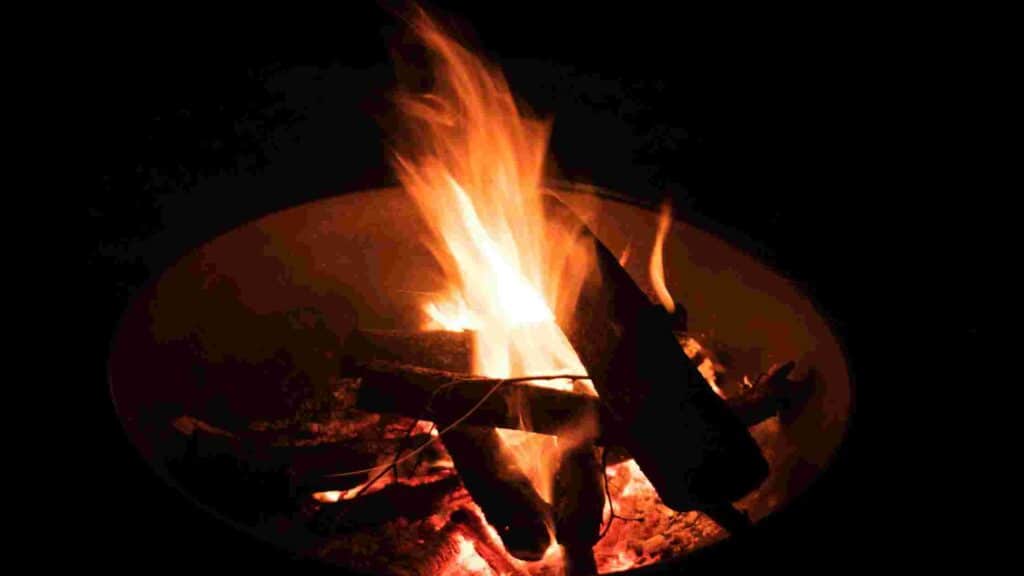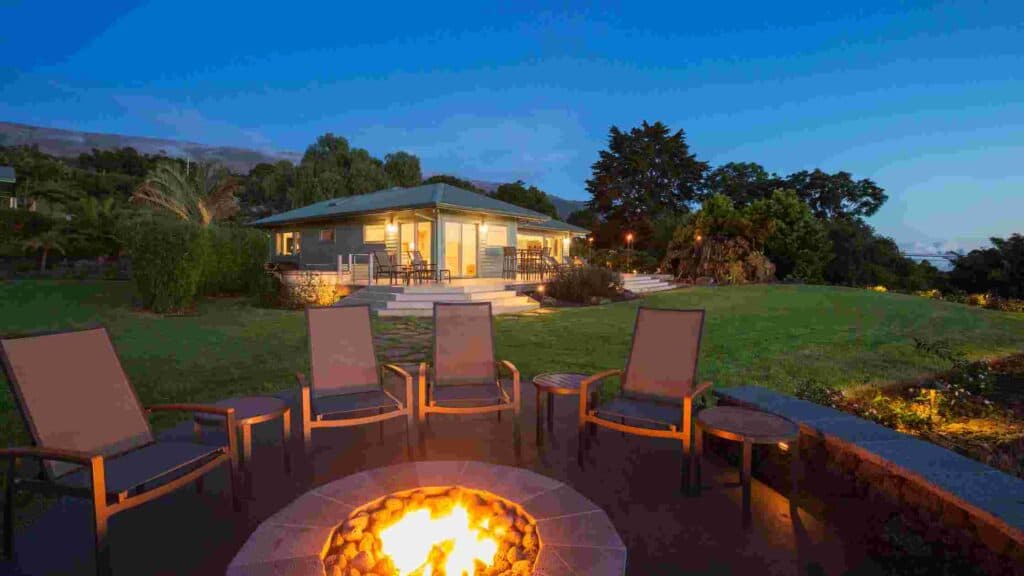In this article, we’ll explore how far should a fire pit be from a house, as well as other important considerations to ensure a secure and enjoyable experience.
Fire pits have become a popular addition to many homes, providing a cozy and inviting atmosphere for outdoor gatherings.
Whether you opt for a high-end model or a portable one, there’s a fire pit style to suit every taste. However, it’s essential to consider safety when deciding where to position your fire pit.
How Far Should A Fire Pit Be From A House?
To begin, it’s crucial to familiarize yourself with local regulations governing fire pit placement.
In general, it is recommended to position your fire pit at least 10 feet away from any buildings or structures that are susceptible to combustion. This includes fences, sheds, decking, trees, shrubs, and other materials that can catch fire easily.
Moreover, it’s advisable to maintain a vertical clearance of approximately 21 feet to minimize fire hazards. Remember, hot air rises, so the farther your fire pit is from the home or other structures, the lower the risk.
Residential Fire Pit Regulations
Before installing a fire pit, it’s vital to familiarize yourself with local regulations established by fire authorities. These regulations may cover various aspects, including permitted fuel types, designated hours of use, fire pit location, and even specific fire pit requirements.
Certain areas may mandate the use of covered fire pits, especially in high fire-risk zones, densely urbanized regions, or places with air quality concerns. Adhering to these regulations ensures both your safety and compliance with local laws.
Find out more in this article: Can I have a fire pit in my backyard?
The Importance Of Fire Pit Safety

Recognizing the importance of fire pit safety, it’s crucial to understand the potential risks involved.
According to the Consumer Product Safety Commission, approximately 6,200 individuals were sent to the emergency room in 2021 due to injuries associated with fire pits or outdoor heaters.
These accidents can result in severe burn injuries, including third and fourth-degree burns, which can cause the loss of a limb, nerve damage, and even permanent disfigurement.
Treating such burns requires extensive medical care, including skin grafts, antibiotics, and ongoing monitoring for complications. Living with the physical and emotional scars of a severe burn can be incredibly challenging.
Avoiding Potential Hazards
In addition to the minimum distance requirement, there are other factors to consider when selecting the perfect spot for your fire pit.
Whether it’s a portable or fixed model, avoid placing the fire pit near underground utilities, power lines, and property boundaries. It’s crucial to find a stable, level, and clear space to ensure the fire pit remains secure and stable during use.
In-Ground Fire Pits
For in-ground fire pits, it is recommended to line the pit with non-combustible materials like bricks and mortar. This helps contain the fire and prevents it from spreading to the surrounding area.
Additionally, the base of the fire pit should be filled with sand or gravel to provide further stability and insulation. Check out our in-ground fire pit ideas for some inspiration.
Creating A Safe Surrounding Area
To enhance safety, consider encircling the fire pit with a border made of non-combustible materials such as sand, gravel, or paving stones. This provides a clear boundary and prevents the fire from accidentally spreading beyond the designated area.
By establishing a well-defined space, you ensure a controlled environment for enjoying your fire pit.
Prioritizing Fire Pit Safety
Owning a fire pit entails a responsibility to prioritize safety measures.
Begin by considering the weather conditions and positioning your fire pit in a location shielded from strong winds. It’s also essential to choose a spot where you can minimize the smoke’s effect on neighbors.
Avoid placing the fire pit near areas with high-foot traffic and have enough room between the fire pit and any surrounding furniture, allowing for easy movement without compromising safety.
Vigilance With Alcohol And Child Safety
Combining fire pits and alcohol consumption can be a dangerous mix.
It’s crucial to exercise caution and avoid any risky behavior near the fire pit, especially while under the influence. Additionally, when it comes to child safety, it’s essential to remain vigilant.
Children are particularly susceptible to accidents around fire pits, given their quick movements and curiosity. Establish clear rules for not running around the fire pit, similar to a swimming pool.
Set safe boundaries, educate children about fire pit dangers, and ensure they understand and abide by the rules to prevent accidents and injuries.
Adult Supervision And Emergency Precautions
Whenever the fire pit is in use, it is imperative that a responsible adult remains present at all times till the fire is completely extinguished.
To deal with an emergency, it’s essential to have immediate access to fire safety equipment. Ensure that a garden hose, sand bucket, or portable fire extinguisher, is readily available nearby.
These precautions will help you respond effectively should any unexpected situations arise.
Covering Flames To Prevent Sparks And Escaping Embers
For safety purposes, it is essential to cover a fire pit producing an open flame using a mesh that is fireproof. This prevents sparks and embers from escaping the fire pit and potentially causing accidental fires.
It’s crucial to refrain from using liquid accelerants when starting a fire. Remember that fire pits should not be used for petroleum products, chemical or toxic materials, rubber or plastic, or burning food waste.
Always consult the guidelines provided by the local government to ensure compliance with regulations.
Choosing The Right Fuel

When it comes to fuel options for your fire pit, wood, and natural gas are the most common choices. Each has its pros and cons to consider.
1. Wood: The Natural Choice
Wood provides a natural and authentic fire experience, creating a mesmerizing ambiance. However, it’s important to note that burning wood emits greenhouse gases and particulate matter into the air.
If you opt for a wood-burning fire pit, it’s essential to consider the availability and cost of wood in your area.
Remember, using wood as fuel requires gathering, chopping, and storing it appropriately, preferably a bit further away from the fire pit. After each use, you’ll need to clean up the coals and ash regularly, which can be beneficial for your garden beds.
2. Propane Gas: The Top Choice For Many
Propane gas is widely regarded as one of the best fuel options for fire pits. It produces a warm and clean flame that can even be used for cooking. One of the key benefits of propane gas is its cost-effectiveness.
Additionally, gas fire pits offer exceptional mobility, allowing you to move them around to make the most of shifting weather conditions.
Once you’re done enjoying the fire, you can easily and safely extinguish it, providing peace of mind (you may also be interested in: Can you roast marshmallows on a propane fire pit?).
3. Natural Gas: A Clean And Convenient Alternative
Natural gas is a cleaner and more eco-friendly fuel option, emitting significantly fewer particulate matter and emissions compared to wood.
If you choose a natural gas fire pit, keep in mind that it will require a permanent installation and connection to the gas line.
This installation can be quite expensive, involving extending the gas line away from the house. Once installed, the fire pit becomes fixed in its location, limiting future mobility.
However, the benefits of natural gas include the ease of use and the ability to use the fire pit for cooking due to the consistent and controllable flame it provides (here are the best fire pit cooking grates).
4. Electric Fire Pits: Flame-Like Faux Elegance
For those seeking a low-maintenance and hassle-free alternative, electric fire pits provide a viable solution. These fire pits feature faux flames that closely resemble real flames, all while being conveniently powered by electricity. It’s important to note that electric fire pits need to be situated near a power source, limiting their placement options. However, if you prioritize simplicity and don’t require an actual flame, an electric fire pit might be the perfect fit.
5. Gel Fuel: Portable Convenience
Gel fuel offers portability and convenience. However, it’s worth noting that it may be challenging to find in certain areas.
While you can purchase wood infused with gel for use in a fireplace, it’s important to remember that gel fuel provides just half the heat output compared to other fuels. Therefore, it’s not recommended for cooking purposes.
If you’re seeking a compact and easily transportable fuel option, gel fuel could be an ideal choice.
Matching Style To Fuel: Considerations For Fire Pit Design
The style and design of your fire pit are influenced by both the chosen fuel and your intended use.
Some individuals prefer to construct their fire pits using heat-safe bricks, employing their creativity to build a personalized design. Square or circular, there are no hard rules when it comes to the shape of your fire pit.
However, if you opt for a wood-burning fire pit, it’s crucial to incorporate proper airflow and cleaning access while also ensuring the inclusion of safety barriers.
FAQs
1. How close can an outdoor fireplace be to a house?
The distance between an outdoor fireplace and a house can vary depending on local regulations and manufacturer recommendations. It is generally advised to maintain a safe distance of at least 10 feet or more.
2. Where should a fire pit be placed in the yard?
A fire pit should be placed in the yard on a non-combustible surface, such as gravel or concrete. It should be positioned away from flammable materials, structures, and overhanging branches.
3. Where not to put a fire pit?
It is not recommended to place a fire pit near flammable structures, such as wooden decks, fences, or overhanging tree branches. Avoid placing it in enclosed or confined spaces that can trap heat or smoke.
You might also be interested in the article: Can you put a fire pit on a deck?
4. What should be the propane fire pit distance from house?
The distance between a propane fire pit and a house should follow the manufacturer’s guidelines. Typically, a safe distance is around 10 feet or more to reduce the risk of heat or gas-related incidents.
5. How far should a fire pit be from a tree?
To ensure safety, a fire pit should be positioned at a distance of at least 10 feet or more away from trees. This helps prevent accidental ignition of tree branches or foliage and reduces the risk of fire spreading to the tree.
Conclusion: How Far Should A Fire Pit Be From A House?
To minimize the risk of combustion, it is advisable to place your fire pit a minimum of 10 feet away from any buildings or structures that can easily catch fire.
By following safety guidelines, adhering to local regulations, and maintaining a vigilant approach, you can enjoy the warmth and ambiance of a fire pit while safeguarding yourself, your loved ones, and your property.
Choose the fuel type that aligns with your preferences, implement safety precautions, and foster a secure and enjoyable environment for all.
